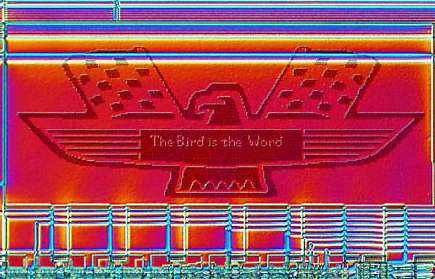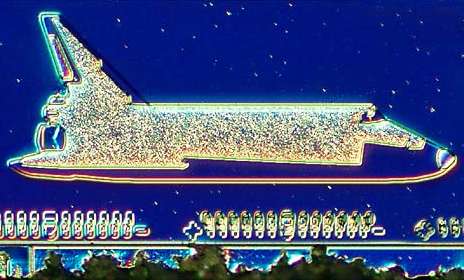The Hewlett-Packard PA-RISC series of microprocessors is highly populated with silicon creatures of all shapes and sizes. Here are some of my favourites.
Velociraptor

This ferocious Velociraptor wireframe dinosaur character was found on the Hewlett-Packard PA-RISC 7300LC. This chip was designed around the time of the Spielberg "Jurassic Park" movie that brought Velociraptors into the public attention. This dinosaur is about 200 microns high as rendered on the chip and he is wearing a pair of sunglasses with the initials "V" on the right lens and "R" on the left lens. It has been brought to our attention that the sunglasses (with the VR initials) might actually be virtual reality glasses, which explains everything.
This Bird's for You !!!

This is a very high magnification view of what appears to be a hummingbird etched into the silicon on a Hewlett-Packard PA-RISC 7000-series microprocessor wafer. The inscription above the bird reads: "This Bird's for You !!!", but we don't think that it is for us. We think that it is for you.
The Bird is the Word

We found this beautiful rendition of the Ford Thunderbird embedded within the PA-7100 microprocessor integrated circuitry, perhaps as a tribute to enthusiasts of the automobile. At over 250 microns high, it is probably the largest silicon creature that we have found to date. The caption: "The Bird is the Word" is probably derived from a 1964 hit song entitled "Surfin' Bird" by a band named The Trashmen. We have also been informed of references to rock band ZZ Top's song "Thunderbird" that sport the lyrics: Have you heard? What's the word? It's Thunderbird. Regardless of the true intentions of the caption, this silicon artwork is some of the finest that we have ever seen.
The Mustang

Imagine finding a wild horse stampeding across the surface of a computer chip. Well, we never imagined it---but here it is! This "American thoroughbred" mustang was discovered galloping around on a Hewlett-Packard PA-RISC microprocessor, flanked by the initials of the chips' designers. This processor was code named "Mustang" and was used in the HP 9000/720 series computers that were designed and built in the early 1990s.
Other beauties include these:
Lotus 7

This exquisite Lotus Seven logo resides on an Atari Simplified Architecture Processor (ASAP) integrated circuit that was provided to us by Michael Albaugh of Atari Games. Michael points out that this car is the type driven by the protagonist in the British television series The Prisoner. The Lotus logo, designed by Mark Pierce, is an indirect reference to the Porsche 911 used by the Berkeley RISC program. The intended message was that the Atari chip was not in the same performance or price class, but could still be an exciting ride. The Lotus 7 is still being produced by Caterham Cars.
Runaway Train

This miniature choo-choo train was discovered rolling down the tracks on a LeCroy MVV 200 analog shift register integrated circuit. The existence of the train was brought to our attention by John T. Anderson of JPS Designs located in Elburn, Illinois. The "tracks" upon which the train is apparently riding are the high speed shift register. This chip is based on Charge-Coupled Device (CCD) technology, where analog samples of electrical charge are temporarily stored in the chevron-shaped tracks, and control signals create electrical fields that "bump" the charge along from segment to segment.
The Space Shuttle

A nice rendition of the space shuttle was captured orbiting a Texas Instruments Advanced Schottky Digital Bipolar Logic integrated circuit. We photographed the shuttle with Differential Interference Contrast (DIC - likewise for the rest of the Silicon Zoo) microscopy using a retardation plate to render a bluish-tinge to the image to simulate orbiting in space. Imperfections in the smooth silicon surface appear as "stars" surrounding the shuttle. Note the jagged edge at the bottom of the photomicrograph where the chip was cut from a wafer using a diamond saw. Russell Crecraft, an engineer who once worked for Texas Instruments, alerted us to the existence of this doodle.
For more stunning silicon works of art, check out the Silicon Zoo section of the excellent Molecular Expressions web site. This has one of the web's largest collections of photomicrographs and is well worth a bookmark - check out these feathers, for example.
 Tel: +44(0)1364 654100
Tel: +44(0)1364 654100
Fax: +44(0)1364 654200
Email: maildesk@greymatter.co.uk
WebSite: http://www.greymatter.co.uk
Post: Grey Matter Ltd, Prigg Meadow, Ashburton, Devon, UK, TQ13 7DF
|
![[Grey Matter]](logo.gif)
![[Grey Matter]](logo.gif)






